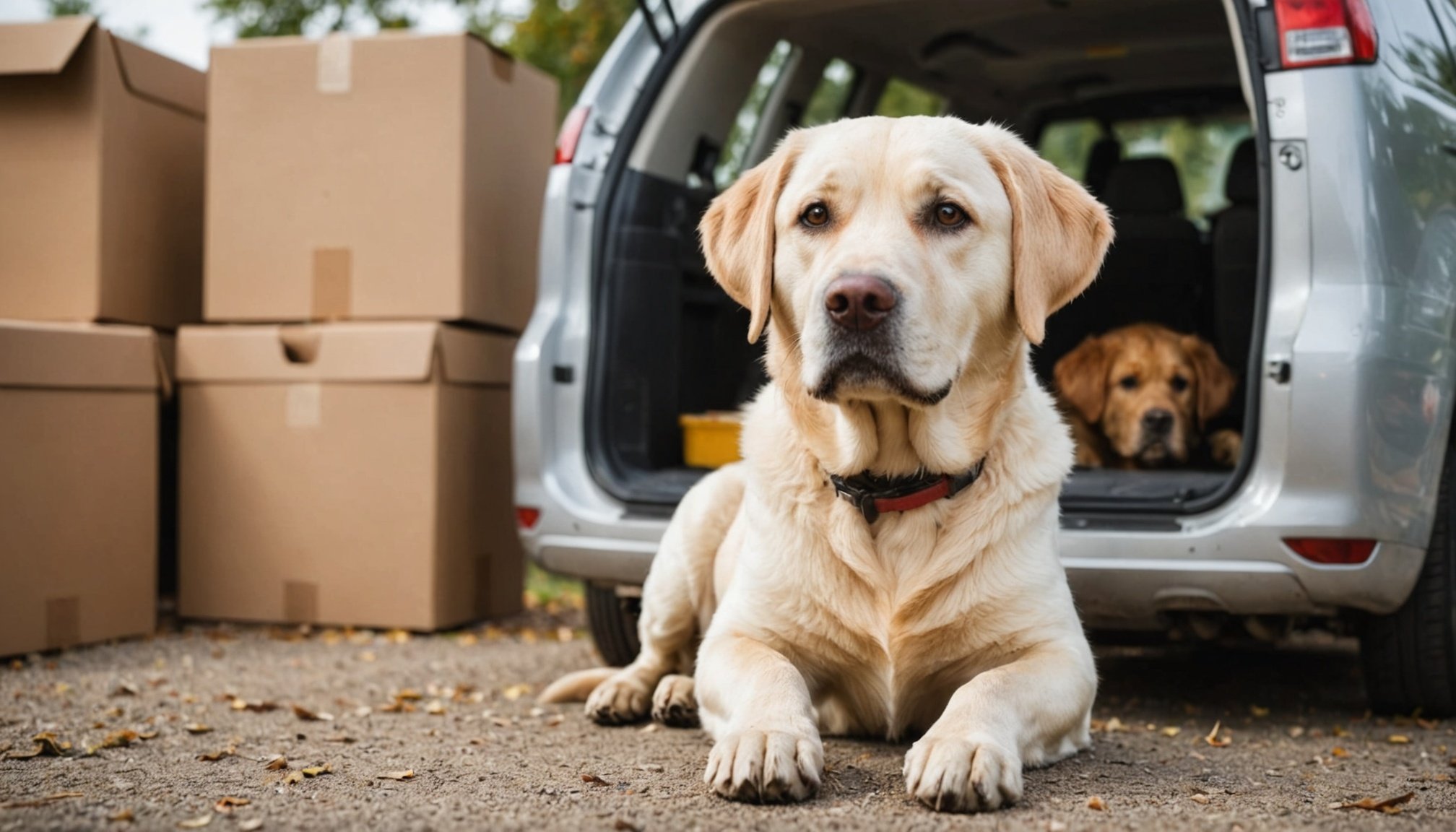Understanding Your Labrador’s Stress During a Move
Relocating can be tough on everyone, including your beloved pets. Recognising signs of stress in Labrador Retrievers is crucial when you’re moving. Labradors might exhibit changes in their behaviour, such as becoming withdrawn, excessively barking, panting, or even displaying destructive acts. It’s essential to be mindful as these can indicate that your pet is feeling stressed.
Various factors contribute to stress in dogs during a move. These include changes in the environment, unfamiliar smells, and the absence of familiar objects. Labradors are creatures of habit; they prefer routine and familiarity, so alterations can be unsettling.
A lire également : Mastering Stair Climbing: A Comprehensive Guide to Teaching Your Italian Greyhound Safe Navigation
The emotional well-being of a dog, especially a Labrador, is pivotal for a smooth transition. When planning a move, consider your pet’s comfort just as much as your own. Introducing your Labrador gradually to the new environment can help alleviate some anxiety. Make sure to keep their routines as consistent as possible during the transition, providing them with plenty of attention and reassurance.
By understanding the unique behaviours associated with stress in your Labrador, you can support them in this change, ensuring the move is stress-free for both you and your furry friend.
En parallèle : Ultimate Guide: How to Create the Perfect Housetraining Schedule for Your Toy Poodle Puppy
Create a Safe Space for Your Dog
Moving with pets can be a challenging experience, both for you and your furry friend. Recognising and establishing a Dog Comfort Zone is crucial to help your pet adjust smoothly. Start by identifying a quiet area in your new home; this location should be away from the hustle and bustle of daily activities. A tranquil spot not only calms your pet but also signals to them their own Safe Space for Dogs.
Utilise familiar items such as toys, blankets, or even a piece of clothing with your scent to reinforce security. These items are comforting reminders of the old environment.
Creating a temporary retreat during the transition period is also beneficial. This could be a cosy corner or a small room equipped with essentials like water, bedding, and snacks. This setup ensures your pet feels less overwhelmed exploring the new environment.
By establishing a Dog Comfort Zone, you foster an atmosphere of trust, accelerating your pet’s adaptation process. A calm dog results in a smoother, less stressful moving experience for everyone involved.
Maintain Routines
Maintaining your dog’s routine is crucial, especially during transitional periods. Regular feeding times help establish a stable daily structure, ensuring your dog knows when to expect meals. This consistency reduces anxiety and supports a sense of security. Similarly, regular exercise plays a vital role in a dog’s routine. Predictable walks or playtime not only contribute to physical health but also offer mental stimulation through familiar activities.
Keeping a dog routine consistent involves more than just feeding and exercise. It includes maintaining familiar activities around these core tasks. Dogs thrive on daily structure—understandably, a big change like moving can disrupt this. To mitigate the stress of such changes, it’s essential to replicate pre-move routines as closely as possible post-move. This familiarity offers comfort in uncertain times.
Implementing strategies to uphold consistency involves thoughtful planning. Prepare for possible changes and anticipate your dog’s reactions. Consistent care means more than maintaining a schedule; it involves empathy and understanding of your dog’s needs. Recognising these needs helps create a supportive environment, reassuring your pet through continuity and care. With these strategies, you help your dog flourish, even in changing circumstances.
Incorporate Calming Products
In today’s busy world, it’s not uncommon for dogs to experience anxiety. Thankfully, Calming Aids for Dogs offer diverse solutions to help soothe their stress. One key product in the Dog Anxiety Solutions category is calming collars. These emit pheromones that mimic a dog’s natural comforting smell, helping them feel more at ease. Paired with anxiety wraps, which apply gentle pressure to a dog’s body, these aids work wonders.
There’s also a growing interest in natural supplements as a means of stress relief for pets. These Relaxation Products often include ingredients like chamomile or valerian root, known for their calming properties. While always consulting with a vet first is advisable, such supplements can significantly enhance your dog’s relaxing experience.
Another approach is to create a serene environment using music specifically designed for dogs or pheromone diffusers. Calming tunes can mask external noises that trigger anxiety, while diffusers release soothing scents into the air. By combining these diverse calming aids, you maximise the chance of effectively alleviating your dog’s anxiety, making life more enjoyable for them and you.
Engage in Play and Exercise
Physical activity is vital for stress reduction in dogs, particularly during times of change like moving. Regular dog exercise not only fosters physical health but also provides a necessary outlet for stress and anxiety. Engaging in interactive play is an effective way to achieve this. During a move, consider incorporating games like fetch or tug-of-war. These activities not only serve as excellent stress relief but also keep your dog engaged and happy.
While scheduling time for exercise during a move might seem challenging, it can be seamlessly integrated into your day. Try setting aside time for short yet spirited play sessions. If you’re moving to a new area, establishing a new walking routine in the neighborhood can benefit both you and your dog. Not only will this routine help your dog adjust to their new environment, but it also serves as a great way to explore your surroundings.
Remember, maintaining a consistent exercise schedule promotes your dog’s well-being, helping them adapt more easily to changes. Whether through spontaneous games or a structured walk, providing your dog with interactive play and exercise opportunities is a great strategy to mitigate stress.
Monitor Behavioral Changes
During a move, dog behavior monitoring becomes crucial. Pay attention to signs of stress, as dogs can experience significant anxiety during such transitions. Behavioural indicators such as excessive barking, pacing, or whining may reveal your pet’s stress levels.
Consider maintaining a journal to track any behavioral changes. Recording your dog’s reactions provides insight into patterns or triggers causing distress. This tool aids in understanding their specific needs and helps in managing their well-being during the upheaval.
If you notice signs of severe anxiety, it might be time to seek professional help. A veterinarian or animal behaviorist can offer strategies to mitigate stress and address ongoing issues effectively. In some cases, intervention may be essential to prevent stressful situations from evolving into more severe problems.
Recognising the signs of stress in dogs ensures that their mental health isn’t overlooked amid the physical chaos of moving. Prioritising this aspect fosters a smoother transition and helps in maintaining a harmonious environment. Noticing, understanding, and acting upon these signs could make all the difference for your furry friend.
Provide Plenty of Love and Attention
The process of relocating can induce stress for both humans and animals, especially affectionate breeds like Labradors. Bonding with dogs becomes crucial during such stressful times. An increase in emotional support for pets can aid in this transition.
Dogs thrive on companionship. Providing affection during this period not only comforts your Labrador but also reinforces your bond. Simple actions like consistent petting, playing familiar games, or enjoying daily walks together can immensely reassure your pet. Positive reinforcement plays a vital role. Praising your Labrador for calm behaviour in the new environment encourages a sense of security and normality.
Adopting new routines creates opportunities for bonding in the new environment. Introduce activities like exploring the neighbourhood or setting up a cosy spot for your pet in your new home. These experiences can be enriching for your Labrador, turning unfamiliar places into spots associated with affection and safety.
Remember, when Labradors receive plenty of love and attention, they feel secure. Showering them with affection during transitions not only makes the adjustment smoother but solidifies your connection, providing a loyal companion through life’s ups and downs.











